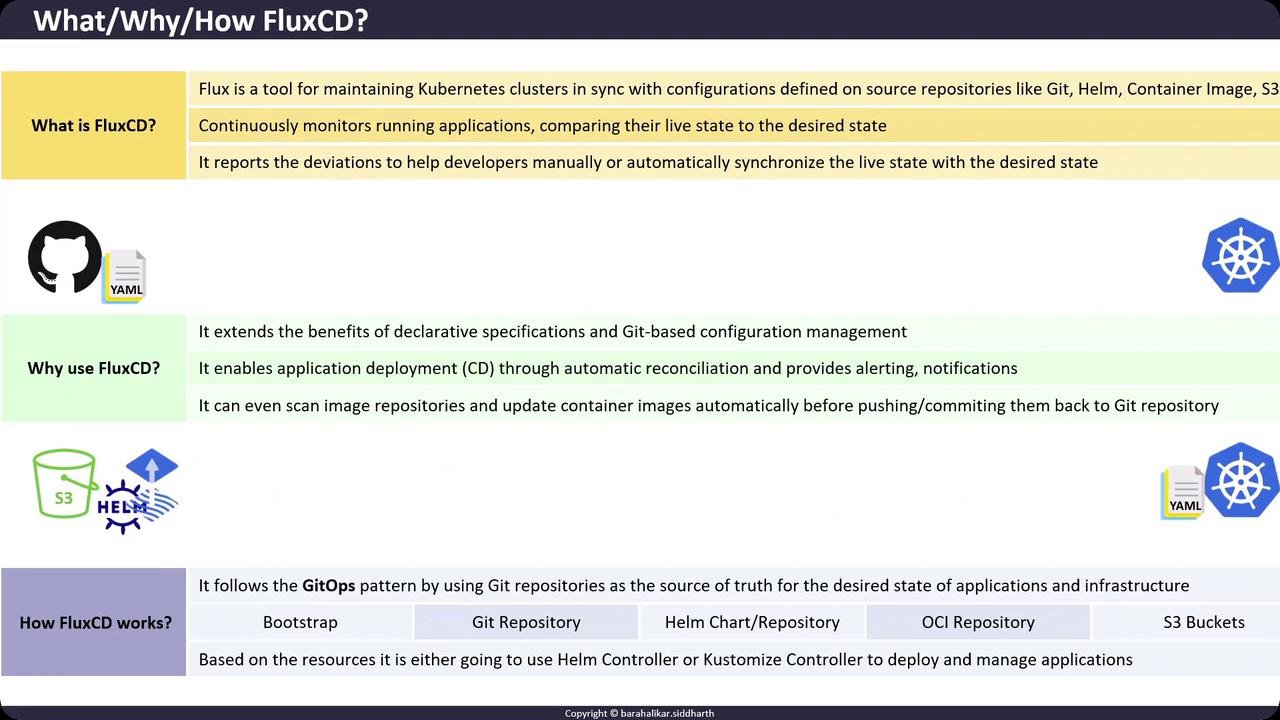GitOps with FluxCD
Flux Overview
WhatWhyHow FluxCD
FluxCD is a Cloud Native Computing Foundation (CNCF) project designed to help teams adopt GitOps for Kubernetes deployment. By treating Git repositories, Helm charts, OCI registries, and S3 buckets as the single source of truth, FluxCD automates synchronization between your declared configuration and the live state of your clusters.
Why Use FluxCD?
Adopting FluxCD delivers multiple benefits:
- Declarative Configuration: Leverage Git’s versioning and audit trail for all cluster changes.
- Automated Reconciliation: Continuously detects and corrects drift between desired and live states.
- Image Automation: Monitors container registries, updates image tags based on policies, and commits changes back to Git.
- Notifications & Alerts: Integrates with Slack, Microsoft Teams, or email to inform you about sync status and failures.
- Scalability: Supports multi-cluster and multi-environment deployments with minimal overhead.
Note
Ensure that you have cluster-admin access on your Kubernetes cluster and the flux CLI installed locally.
For installation instructions, see FluxCD Getting Started.
What Is FluxCD?
FluxCD is a set of Kubernetes controllers and custom resources that continuously reconcile the state of a cluster with configurations stored in external sources:
- Git Repositories: YAML manifests, Kustomize overlays, or Helm releases.
- OCI Registries: Helm charts or container images.
- Cloud Storage: S3 buckets or other object storage for raw manifests.
By adopting a GitOps workflow, every change in your cluster must be made via pull requests, ensuring a clear history and enabling code review practices.
How Does FluxCD Work?
FluxCD implements GitOps by actively monitoring your declared sources and the cluster’s live state. When it detects a difference, it reports the drift and—depending on your policy—reconciles automatically or waits for manual approval.

Below is a high-level command sequence to bootstrap FluxCD on a Git repository:
# Install Flux CLI
curl -s https://fluxcd.io/install.sh | sudo bash
# Bootstrap Flux with GitHub
flux bootstrap github \
--owner=<your-github-user> \
--repository=<repo-name> \
--branch=main \
--path=clusters/my-cluster
FluxCD Controllers at a Glance
| Controller | Source Type | Primary Function | Flux CLI Example |
|---|---|---|---|
| Kustomize Controller | Git, S3 | Applies Kustomize overlays to generate YAML | flux create kustomization |
| Helm Controller | Git, OCI Rep. | Manages Helm chart releases declaratively | flux create helmrelease |
Kustomize Controller
The Kustomize Controller is a Kubernetes operator that applies and manages manifests assembled by Kustomize. It is ideal for:
- Layered environment configurations (e.g., dev, staging, prod).
- Declarative customization of base manifests without forking.
Helm Controller
The Helm Controller enables you to synchronize Helm chart releases using standard Kubernetes manifests:
- Define
HelmReleasecustom resources to specify chart version, values, and target namespace. - FluxCD will automatically install, upgrade, or rollback charts based on Git commits.
Warning
When using the Helm Controller, ensure your cluster can pull images from the specified OCI registries. You may need to configure image pull secrets.
Further Reading
Watch Video
Watch video content